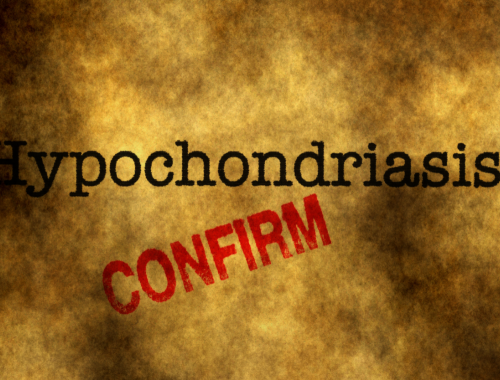Difference Between Somatization and Hypochondriasis
Somatization is a problem where a person has physical symptoms because of underlying psychological issues. Hypochondriasis is when a person worries that they are ill or may become ill despite no evidence that they are ill or will become ill.

What is Somatization?
Definition:
Somatization is defined as the condition where a person has vague symptoms which are due to psychological problems and not medical conditions.
Causes and prevalence:
A combination of anxiety and depression are mainly believed to cause somatization. The condition is more common in women than men. Somatization is most often diagnosed in women who are in their mid-30s although people of any age can have this condition, including older people.
Symptoms:
Many people with somatization have vague complaints such as having a sore head, feeling very tired, and having sore legs and arms. They also often report a crawling sensation on their skin and feel like their heart is beating too fast.
Diagnosis:
A physical exam can exclude physical illnesses as a cause of the condition. A patient will often have vague symptoms of exhaustion and pain that last more than 6 months and cause the person much anxiety.
Treatment:
Treatment may include cognitive-behavioral therapy (CBT) and psychotherapy. Sometimes antidepressant medicines can help alleviate some of the depression that patients may have.

What is Hypochondriasis?
Definition:
Hypochondriasis is the unusual worry and anxiety that a person has over being ill even though they are not ill. The condition is now more commonly called illness anxiety disorder.
Causes and prevalence:
The condition is uncommon only happening in about 0.1% of people; it is diagnosed most often in the early part of adulthood.
Symptoms:
The symptoms of hypochondriasis are an excessive worry about being ill despite there being no evidence of illness. The person visits the doctor or hospital often and wants many medical tests. The person talks a lot about their health and may excessively research medical problems online.
Diagnosis:
Diagnosis is based on the person worrying about their health for 6 months and more even though there is no basis for their concern. The person’s behavior in frequently seeking medical help is also indicative of the condition.
Treatment:
Treatment of hypochondriasis is by a couple of methods. Traditional CBT and internet-delivered exposure-based CBT (ICBT) can be used. Antidepressants such as amitriptyline or fluoxetine are sometimes also used.
Difference between Somatization and Hypochondriasis?
Definition
Somatization is a disorder where a person has symptoms but these are not due to a physical problem. Hypochondriasis is a condition where a person thinks they are ill and is worried about illness even though they do not have a medical condition.
Prevalence
Somatization is most commonly diagnosed in women of an average age of 35. Hypochondriasis is most often noticed in early adulthood in both men and women.
Symptoms
The symptoms of somatization include a headache, a crawling sensation on the skin, sore limbs, and a feeling that the heart is beating out of control. The symptoms of hypochondriasis include worrying excessively over being ill and frequent trips to the doctor.
Causes
The causes of somatization are anxiety and depression. The causes of hypochondriasis vary but are thought to be related to childhood trauma, abuse, and mental problems such as anxiety and depression.
Treatment
The treatment options for somatization include CBT, psychotherapy, and medication. The treatment options for hypochondriasis include CBT, medication, and ICBT
Table comparing Somatization and Hypochondriasis

Summary of Somatization Vs. Hypochondriasis
- Hypochondriasis is an anxiety problem where a person worries excessively over their health.
- Somatization is when physical symptoms are due to psychological problems.
- Somatization and hypochondriasis are both conditions that are treated using a combination of therapy and medication.
FAQ
What is the difference between hypochondria and hypochondriasis?
There is no difference, both terms refer to the same condition.
Is hypochondriasis a somatic disorder?
Yes, hypochondriasis has been called a somatic disorder, but it is more commonly thought of as an anxiety disorder today.
What is the difference between somatic symptom disorder and somatization?
There is no difference. Both somatic symptom disorder and somatization refer to the same condition.
What is an example of somatization?
Feeling nauseated for no physical reason is an example of somatization.
What is the new term for hypochondriasis?
Hypochondriasis is now called illness anxiety disorder.
What is the new name for somatization disorder?
Somatization disorder is now called somatic symptom disorder.
What are the two types of somatization disorder?
Conversion disorder and body pain disorder are two forms of somatization disorder.
What is somatization behavior?
People will often say they are in pain and have headaches and fatigue but the cause of this is not a physical malady.
What are symptoms of somatization?
Symptoms include headaches, pain in the limbs, and fatigue.
- Difference Between Rumination and Regurgitation - June 13, 2024
- Difference Between Pyelectasis and Hydronephrosis - June 4, 2024
- Difference Between Cellulitis and Erysipelas - June 1, 2024
Search DifferenceBetween.net :
Leave a Response
References :
[0]Dimsdale, Joel E. “Illness Anxiety Disorder”. Merckmanuals. Merck & Co., 2022, https://www.msdmanuals.com/professional/psychiatric-disorders/somatic-symptom-and-related-disorders/illness-anxiety-disorder
[1]Kellner, Robert. "Somatization: Theories and research." The Journal of nervous and mental disease 178.3 (1990): 150-160.
[2]Obimakinde, A. M., M. M. Ladipo, and A. E. Irabor. "Symptomatology and comorbidity of somatization disorder amongst general outpatients attending a family medicine clinic in South West Nigeria." Annals of Ibadan postgraduate medicine 12.2 (2014): 96-102.
